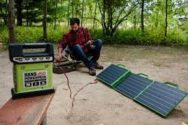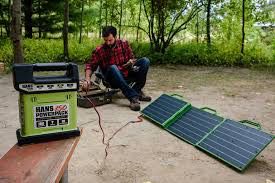
Best portable power stations to buy in 2021
 Whether you are living off-grid or just moving arond for business or leisure, keeping powered up is an important part of your preparations. Portable power stations are the smaller, lesser-known cousin of generators. These easily-packed gadgets can go with you on camping trips, to building sites — wherever you need electricity — to keep your phone, power tools and other electronics running.
Whether you are living off-grid or just moving arond for business or leisure, keeping powered up is an important part of your preparations. Portable power stations are the smaller, lesser-known cousin of generators. These easily-packed gadgets can go with you on camping trips, to building sites — wherever you need electricity — to keep your phone, power tools and other electronics running.
We picked seven power stations to test for this list, ranging in price from $270 to $1,200. We focused exclusively on rechargeable battery-powered models, although gas models are available, too. While each power station does the same thing — provide power on the go in a compact design — each one has a different design and range of features.
Keep in mind that the prices for each power station may change as retailers introduce sales and other updates.
Best overall
The Jackery Explorer 1000 is by far the most well-rounded portable power station of the bunch. At 22 pounds, this powerful generator is fairly compact, especially compared with the 44-pound Ego Nexus model. Despite its smaller size, it manages to make space for three three-prong outlets, two USB-C ports, two standard USB-A ports and more.
Its display is easy to read, too, and it dominated the performance tests, exceeding its expected run time of 3 hours and 2 minutes (with three work lights connected to it) by an average of 8.5 minutes.
You can add on the 100W Solar panel for another $300
Fast facts
* Price (Amazon): $1,000
* Watt hours: 1,002
* Weight: 22 pounds
Best midrange
When you don’t need something quite as powerful as the Jackery Explorer 1000, the Klein Tools KTB5 is an excellent option. While it has roughly half the watt hours of the Jackery generator, it’s still a solid performer with a lot of power.
Complete with two three-prong outlets, two USB-C ports and two USB-A ports, you can charge pretty much anything you’ll ever need with this midrange power station. Bonus: It did well in my performance tests, averaging just 2 minutes less than its expected 2-hour and 29-minute run time (with two lights connected to it).
Fast facts
* Price (Amazon): $500, currently on sale for $465
* Watt hours: 546
* Weight: 12 pounds
Best budget
The Rockpals 300W is our pick for affordable portable power station. Not only did it average 2.5 minutes over the expected 2-hour 33-minute run time (with one work light connected), it’s only 7.5 pounds and has a ton of options, ranging from one three-prong outlet to four USB-A ports and a handful of other features.
$270 isn’t exactly budget, but it’s the most affordable model tested — and its strong performance and solid lineup of features give it even more value.
Fast facts…






